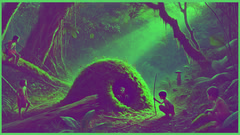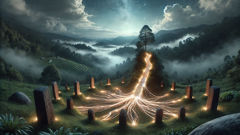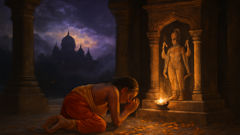Introduction
In the heart of the Philippine archipelago, there are forests older than memory—vast expanses where ancient trees stand like silent sentinels, their thick canopies breathing secrets into the wind. Here, sunlight filters through the tangled branches, painting the ground in shifting mosaics of gold and green. The air is thick with the scent of damp earth, wild ginger, and the distant perfume of ylang-ylang flowers. But among all the sights and scents, there’s a deeper presence, something unseen yet ever-present, woven into the very fabric of the land. Villagers say that in these places, where the earth rises in small, curious mounds—punso—one must tread with caution and speak with respect. For within these humble anthills lives the Nuno sa Punso, a spirit as ancient as the roots of the mahogany trees themselves.
The Nuno sa Punso is not a creature of grand spectacle. He does not thunder like the Aswang or flicker with the mischief of a Tikbalang. Instead, he waits quietly, dwelling beneath the mounds, peering up at the world with eyes wise and wary. Described as a small, gnarled figure—dwarf-like and wizened—he is both feared and revered. The people know better than to disturb his home. They whisper apologies before crossing his path, offer small tokens at the base of his punso, and teach their children the importance of humility before the unseen. Those who forget, who trample over his dwelling or mock his existence, are said to fall victim to mysterious ailments or a streak of misfortune that defies explanation.
Yet not every encounter with the Nuno is a tale of woe. The Nuno is a guardian of balance, a spirit who punishes only when provoked, and sometimes rewards kindness or humility with unexpected fortune. His legend is more than a story—it’s a living reminder of the delicate harmony between people and the land, of the respect owed to nature and the mysteries it holds. The tale you are about to read is woven from the threads of these beliefs—a journey through thick forest, whispering bamboo, and moonlit clearings, where a single careless act can shift the course of destiny. It is a story of a young boy named Datu, whose curiosity led him to the threshold of the spirit world, and whose courage and wisdom would be tested by the enigmatic Nuno sa Punso.
The Forbidden Mound
Datu was the youngest son of the village potter, a wiry boy with quick eyes and a heart as restless as the river that threaded through their land. He had grown up on stories—tales of spirits and giants, of shapeshifters and enchanted trees—but he wore his skepticism like a badge. In his mind, spirits belonged to the realm of bedtime stories and old women’s warnings, not in the day-to-day world of fishing, planting, or running barefoot through the woods. Still, he was not disrespectful; he simply wondered what truth lay behind the fear.

One humid afternoon, when the air buzzed with the calls of cicadas, Datu set off into the forest to gather firewood. His mother had told him to stay on the paths, to avoid the shaded clearings where the punso mounds clustered like sleeping animals. But the best wood was always deeper in, where wild lanzones trees dropped sweet fruit and the ground was cool beneath the boughs. Datu wandered until he found himself in an unfamiliar glade, lit by the soft green light that filtered through a dense lattice of leaves. At the center of the clearing sat a punso—taller than any he’d seen, carpeted with moss and ringed by delicate ferns.
His gaze lingered on the mound. There was nothing remarkable about it, save for a curious sense that the air around it was heavier, more silent. The hairs on his arms prickled. Datu remembered his mother’s warning: “Always say tabi-tabi po when you pass a punso. The Nuno listens.” But Datu, emboldened by solitude and a desire to test the truth, merely grinned and prodded the mound with a stick, watching as a trickle of red ants emerged in protest. He laughed, thinking how silly it was to be afraid of dirt and insects.
Suddenly, a wind rustled through the clearing, though the trees stood still. The air shifted, thick with the scent of crushed grass and something metallic. Datu felt an odd twinge in his left foot—a numbness that crept up his leg like cold water. He shrugged it off and began gathering wood, but by the time he returned home, his steps had become uneven, and his skin itched with a prickling heat.
That night, Datu tossed feverishly in his bamboo bed. Strange dreams swirled in his mind: a shadowy figure crouched atop the mound, its eyes burning like embers beneath a tangled beard. Whispers echoed in a language he could not understand. When he woke at dawn, his foot had swollen, red and angry as if stung by a hundred bees. His mother gasped, her eyes wide with fear. She knew, as all villagers did, what had happened. Datu had angered the Nuno sa Punso.
His father called for the village albularyo—the healer—who inspected the foot, muttered incantations, and burned herbs that filled their hut with acrid smoke. But nothing eased Datu’s pain. By the second day, a rash had crept up his leg, and his fever left him delirious. Neighbors whispered outside their door, recalling stories of children struck down by curses, of men who lost their minds after offending the spirit. Datu, weakened and afraid, began to realize that some stories were more than just warnings—they were woven into the bones of the land.
Whispers Beneath the Roots
As Datu’s fever raged, his dreams grew stranger and more vivid. He found himself wandering through endless forests, where the trees whispered secrets and every shadow seemed alive. Sometimes he glimpsed the Nuno—a squat, ancient figure with skin like bark, dressed in tatters of vine and moss. Other times, he heard only a faint chanting, as though the very earth were speaking.

His mother pleaded with him to apologize to the Nuno. “You must ask forgiveness,” she said softly, wiping his brow with a damp cloth. “The spirits are older than we are. They do not forget.”
On the third night, as rain drummed against the nipa roof, Datu’s grandmother arrived. She was a tiny woman, her hair long and silver, her eyes sharp as tamarind leaves. She carried a bundle of dried herbs and a necklace of tiny shells. Sitting by Datu’s bedside, she whispered prayers in a dialect so old it felt like song. When dawn broke, she took Datu’s trembling hand. “We must go to the punso,” she said, “and you must ask the Nuno to lift his curse.”
With the help of his father and grandmother, Datu limped back into the forest. The journey was slow, the swollen foot throbbing with every step. When they reached the clearing, his grandmother knelt before the mound, scattering rice grains and betel nut at its base. She urged Datu to kneel as well. The boy, humbled and afraid, pressed his forehead to the earth. “Tabi-tabi po, Nuno,” he whispered. “Forgive me. I did not mean to disturb your home.”
For a long moment, nothing happened. The forest was hushed, the only sound the distant call of a koel bird. Then, from within the mound, a faint rustling arose. The moss parted, and a tiny figure emerged—no taller than a coconut sprout, draped in robes of decaying leaves. His face was wrinkled and stern, eyes bright as river stones. He studied Datu with ancient patience.
“Why did you disturb my home?” The voice was thin and brittle as dry twigs, yet it echoed in Datu’s mind.
“I was foolish,” Datu stammered. “I did not believe.”
The Nuno regarded him for what felt like an eternity. Then he spoke, not with anger, but with quiet disappointment. “The land remembers every step, every word. When you forget to honor what is old, you dishonor yourself.”
Datu’s grandmother offered a bowl of fresh water and a small woven mat. The Nuno accepted these with a grave nod. He reached out a knotted hand and touched Datu’s swollen foot. Instantly, the pain ebbed, and the rash faded as if drawn back into the soil. The Nuno’s eyes softened. “Learn respect for what you cannot see. And teach others. The forest is not yours alone.”
As the Nuno retreated into his punso, the sunlight shifted, dappling the mound with golden light. Datu bowed low, gratitude and awe filling his heart. The lesson lingered long after the fever faded: there is power in humility, and in honoring the mysteries that dwell beneath the roots.
Conclusion
Datu’s journey left a deep imprint on his heart. From that day forward, he became the village’s most ardent protector of old customs. He reminded his friends to greet each punso with respect, to leave tokens of thanks after harvest, and to never mock the unseen. As he grew, Datu passed these lessons on to his children and grandchildren, ensuring that the story of the Nuno sa Punso lived on—carried in song, whispered in moonlit gatherings, and taught beneath the shade of ancient trees. The villagers, too, learned to see the forest not just as a resource, but as a living world of spirits and secrets. They understood that every mound might shelter a guardian, that every rustle in the grass could be a gentle warning. The land flourished, wild and generous, as long as it was treated with respect. Even now, when travelers wander through Philippine forests and stumble upon curious mounds, they pause and whisper, “Tabi-tabi po.” For the Nuno sa Punso still listens, watching from beneath the roots, guarding the delicate balance between people and the earth.













